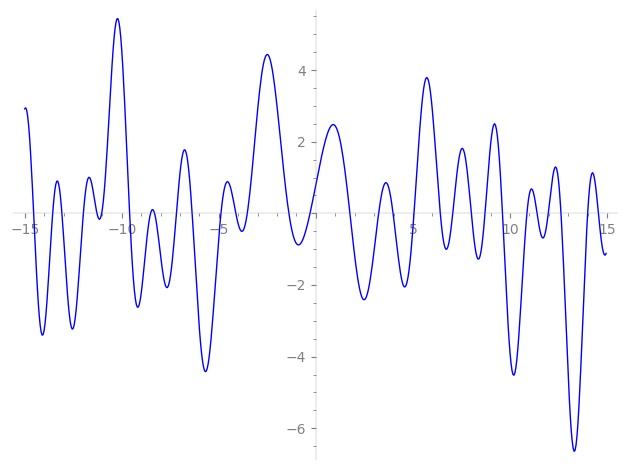| L(s) = 1 | + (−7.52 − 4.34i)5-s + (2.97 − 6.33i)7-s + (11.7 − 6.80i)11-s + 11.1·13-s + (−21.5 + 12.4i)17-s + (11.6 − 20.1i)19-s + (−8.87 − 5.12i)23-s + (25.2 + 43.8i)25-s − 14.5i·29-s + (−15.7 − 27.2i)31-s + (−49.9 + 34.7i)35-s + (−22.1 + 38.2i)37-s − 8.92i·41-s − 56.8·43-s + (−29.8 − 17.2i)47-s + ⋯ |
| L(s) = 1 | + (−1.50 − 0.869i)5-s + (0.425 − 0.904i)7-s + (1.07 − 0.618i)11-s + 0.859·13-s + (−1.26 + 0.730i)17-s + (0.613 − 1.06i)19-s + (−0.385 − 0.222i)23-s + (1.01 + 1.75i)25-s − 0.500i·29-s + (−0.507 − 0.878i)31-s + (−1.42 + 0.992i)35-s + (−0.597 + 1.03i)37-s − 0.217i·41-s − 1.32·43-s + (−0.636 − 0.367i)47-s + ⋯ |
\[\begin{aligned}\Lambda(s)=\mathstrut & 756 ^{s/2} \, \Gamma_{\C}(s) \, L(s)\cr =\mathstrut & (-0.989 + 0.146i)\, \overline{\Lambda}(3-s) \end{aligned}\]
\[\begin{aligned}\Lambda(s)=\mathstrut & 756 ^{s/2} \, \Gamma_{\C}(s+1) \, L(s)\cr =\mathstrut & (-0.989 + 0.146i)\, \overline{\Lambda}(1-s) \end{aligned}\]
Particular Values
| \(L(\frac{3}{2})\) |
\(\approx\) |
\(0.8083818405\) |
| \(L(\frac12)\) |
\(\approx\) |
\(0.8083818405\) |
| \(L(2)\) |
|
not available |
| \(L(1)\) |
|
not available |
\(L(s) = \displaystyle \prod_{p} F_p(p^{-s})^{-1} \)
| $p$ | $F_p(T)$ |
|---|
| bad | 2 | \( 1 \) |
| 3 | \( 1 \) |
| 7 | \( 1 + (-2.97 + 6.33i)T \) |
| good | 5 | \( 1 + (7.52 + 4.34i)T + (12.5 + 21.6i)T^{2} \) |
| 11 | \( 1 + (-11.7 + 6.80i)T + (60.5 - 104. i)T^{2} \) |
| 13 | \( 1 - 11.1T + 169T^{2} \) |
| 17 | \( 1 + (21.5 - 12.4i)T + (144.5 - 250. i)T^{2} \) |
| 19 | \( 1 + (-11.6 + 20.1i)T + (-180.5 - 312. i)T^{2} \) |
| 23 | \( 1 + (8.87 + 5.12i)T + (264.5 + 458. i)T^{2} \) |
| 29 | \( 1 + 14.5iT - 841T^{2} \) |
| 31 | \( 1 + (15.7 + 27.2i)T + (-480.5 + 832. i)T^{2} \) |
| 37 | \( 1 + (22.1 - 38.2i)T + (-684.5 - 1.18e3i)T^{2} \) |
| 41 | \( 1 + 8.92iT - 1.68e3T^{2} \) |
| 43 | \( 1 + 56.8T + 1.84e3T^{2} \) |
| 47 | \( 1 + (29.8 + 17.2i)T + (1.10e3 + 1.91e3i)T^{2} \) |
| 53 | \( 1 + (79.6 - 46.0i)T + (1.40e3 - 2.43e3i)T^{2} \) |
| 59 | \( 1 + (-3.07 + 1.77i)T + (1.74e3 - 3.01e3i)T^{2} \) |
| 61 | \( 1 + (-31.3 + 54.2i)T + (-1.86e3 - 3.22e3i)T^{2} \) |
| 67 | \( 1 + (-58.9 - 102. i)T + (-2.24e3 + 3.88e3i)T^{2} \) |
| 71 | \( 1 + 56.6iT - 5.04e3T^{2} \) |
| 73 | \( 1 + (-32.7 - 56.6i)T + (-2.66e3 + 4.61e3i)T^{2} \) |
| 79 | \( 1 + (4.51 - 7.82i)T + (-3.12e3 - 5.40e3i)T^{2} \) |
| 83 | \( 1 + 39.9iT - 6.88e3T^{2} \) |
| 89 | \( 1 + (26.5 + 15.3i)T + (3.96e3 + 6.85e3i)T^{2} \) |
| 97 | \( 1 + 137.T + 9.40e3T^{2} \) |
| show more | |
| show less | |
\(L(s) = \displaystyle\prod_p \ \prod_{j=1}^{2} (1 - \alpha_{j,p}\, p^{-s})^{-1}\)
Imaginary part of the first few zeros on the critical line
−9.594977749362098594830492544699, −8.516638162263078897735507396340, −8.310272810083677205012354096667, −7.18484770743036042152645222571, −6.37576941583191539096541918461, −4.88987794746978834693839106837, −4.12298048639014613785289090409, −3.53533641331178265991276276958, −1.39093540645271588115650368050, −0.30282734985448878426994941973,
1.75177436875895215198679792448, 3.23175681868461092186714128345, 3.97479314736750626770501325052, 5.05259982970961957901446722628, 6.40765385369424138745430622121, 7.04919152922100361552518205196, 8.006648455536387107289771943863, 8.710219239393333026705507788958, 9.610090053175894719886073917953, 10.86985118939322022946138354419

